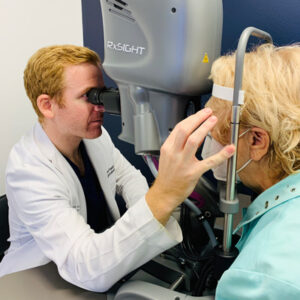Ophthalmology News
August 2009
by Marguerite B. McDonald, M.D.
A common but underdiagnosed condition, blepharitis presents the clinician with several challenges. Not only is diagnosis complicated by the frequent co-occurrence of other ocular surface conditions with similar symptoms, but traditional regimens to treatment have been largely unsatisfactory. However, with the recent introduction of an ophthalmic formulation of azithromycin (AzaSite, Inspire Pharmaceuticals, Durham, N.C.), we have a new antibiotic option for the treatment of blepharitis, and early experience with this drug suggests that it may prove effective.
Prevalence and symptoms
While the prevalence of blepharitis has not been definitively studied, some clinicians estimate that this condition may affect up to 15% of the population.1 Posterior blepharitis likely plays a role in at least one-third of all cases of dry eye disease, and blepharitis frequently coexists with ocular allergy. Given the high prevalence of both dry eye disease and ocular allergy, a high prevalence of blepharitis is to be expected. In most cases, symptoms of blepharitis include ocular redness and irritation, often described as an itching or burning sensation. Symptoms are usually worse in the morning, and patients also frequently complain of “crusting” on awakening. Left untreated, blepharitis can cause dry eyes, loss of cilia, formation of chalazia and hordeola, and even corneal ulceration and vascularization. Untreated blepharitis is a common cause of Salzmann’s nodular dystrophy. In addition, blepharitis greatly increases the risk of endophthalmitis following ocular surgery.
Treatment considerations
Although rarely sight-threatening, blepharitis can cause chronic discomfort as well as potentially serious surgical complications. Because of their red, “bleary” eyes, blepharitis patients’ friends and coworkers may assume the cause is an alcohol or drug abuse problem, a misconception that can have a devastating effect on patients’ personal and professional lives. Alleviating this redness and irritation can significantly improve patients’ quality of life, so blepharitis should be treated—even when it is not the patient’s primary complaint. Proper treatment of blepharitis is also essential for preventing infectious complications following ophthalmic surgery. The bacteria that cause endophthalmitis and other post-op infections typically originate in the lid margin flora, so the overgrowth of bacteria that characterizes untreated blepharitis can significantly increase patients’ risk of post-op infectious complications. Posterior blepharitis can also affect patients’ quality of vision, so treatment may be necessary to achieve optimal visual outcomes in cataract and refractive surgery.
Anterior vs. posterior blepharitis
While anterior and posterior blepharitis share many symptoms, the two conditions differ in several significant ways. Many patients have “mixed blepharitisj,” i.e.: They suffer from both anterior and posterior blepharitis. I aim to distinguish between the two conditions whenever possible, however, especially since some treatments are appropriate only to one condition or the other.
There is significant overlap in the symptoms of anterior and posterior blepharitis. The patients may complain of burning (a classic blepharitis complaint); excessive tearing; red eyelids; puffy eyelids; sore eyelids; red eyes; lash loss; foreign body sensation; light sensitivity; and crusting or matting of the lids in the morning. They may also have a history of previous hordeola and/or chalazia, from the recent or far distant past.
Characterized by excessive colonization of the lid margin, anterior blepharitis is a chronic infectious condition often caused by Staphylococcus aureus, Staphylococcus epidermidis, and Corynebacterium spp. Typical clinical findings in anterior blepharitis include collarettes at the base of each eyelash and erythema and edema of the lid margin. In posterior blepharitis (also called meibomian gland disease), patients complain of similar symptoms. Because of the key role meibomian gland inflammation plays in this condition, however, these patients frequently exhibit additional signs, including inspissation of the meibomian glands, telangiectasia, and thickened eyelid margins.
In many cases, inflammation of the meibomian glands decreases the quantity and quality of meibomian gland secretions in the tear film, resulting in evaporative dry eye disease. In the healthy eye, meibomian gland secretions are essential for stabilizing the tear film and limiting tear film evaporation, so any alteration in meibomian gland secretions can precipitate the development of an unstable tear film and ocular drying (Figures 3A and 3B). Also, bacterial lipases can break down meibomian gland secretions, producing soaps and fatty acids in the tear film that are irritating to the ocular surface and can give the tear film a foamy appearance.
Differential diagnoses
Given the overlap in symptoms and frequent co-occurrence of blepharitis and dry eye disease, the clinical picture may be complex. Asking patients when during the day their symptoms peak can help to clarify the diagnosis, since blepharitis and dry eye disease exhibit different diurnal patterns.
In blepharitis, prolonged exposure to inflammatory mediators in the tear film during sleep causes ocular irritation, and blepharitis patients tend to be most uncomfortable early in the morning. For dry eye disease patients, discomfort worsens as the eye is exposed to the environment throughout the day, so their symptoms typically peak in the afternoon or evening.
When both blepharitis and dry eye disease are present, patients typically show a bimodal pattern. These patients often report that their eyes are uncomfortable upon awakening but improve by midday, and then worsen again in the afternoon or evening.
Limitations of traditional treatments
Once the history and clinical examination have established a diagnosis of blepharitis, several treatment options can be considered. Depending on the severity of the condition and whether the patient has anterior or posterior blepharitis, treatment options may include both lid hygiene and antibiotic therapy.
Until recently, treatment for blepharitis consisted primarily of warm compresses and lid scrubs. For both anterior and posterior blepharitis, patients were advised to apply warm compresses to the lids to promote the secretion of meibomian gland fluids and to loosen the scurf and debris for easier removal. Patients then cleaned their lids and lashes with non-detergent cleansers created specifically for this purpose. In addition, some patients with posterior blepharitis were treated with topical antibiotic ointments applied at night, and oral tetracyclines. (The latter are used for their anti-inflammatory rather than their antibiotic effects.). As we all know, some patients reject antibiotic ointment therapy. These ointments can be difficult to apply, can cause dangerous blurring for elderly patients who get up at night (and sometimes in the morning), and can leave a residue on the patient’s hair and pillowcase. Nevertheless, there were no other options until recently. I also recommended (and still recommend) that blepharitis patients increase their consumption of omega-3 fatty acids, by altering their diet and taking nutritional supplements.
Antibiotic treatment
While traditional treatment of blepharitis often provides at least some improvement in symptoms, the ideal treatment would address the infectious as well as the inflammatory aspects of the disease. However, most current antibiotic drugs are not suitable for treating blepharitis because traditional antibiotics do not penetrate and remain active in lid tissue to any significant degree and would require unacceptably frequent dosing to achieve a therapeutic effect. And the most widely used ophthalmic antibiotics, the fluoroquinolones, are not anti-inflammatory.
A new ophthalmic formulation of azithromycin could overcome these obstacles. Although currently indicated only for the treatment of bacterial conjunctivitis, azithromycin ophthalmic solution 1% has several properties that suggest it could also prove effective for treating blepharitis, and early clinical trials support this possibility.
Since blepharitis is a chronic condition that can take weeks or months to resolve, any drug used to treat this condition must be able to maintain therapeutic concentrations in the target tissues without continuous dosing. Supporting azithromycin’s ability to achieve this goal, a recent animal study found that when azithromycin was administered according to the dosing regimen detailed in the package insert (twice a day for 2 days, then once a day for another 5 days), drug concentrations in cornea, conjunctiva, and eyelid tissue remained above the MIC50 level for typical bacterial pathogens for as long as 5 days following the last dose.2 A similar study measuring the drug concentration in conjunctival tissue of human volunteers found a mean concentration of 32 μg/g 24 hours after a single dose.3 In addition to azithromycin’s sustained antibacterial effect, this drug—like the tetracyclines—also exhibits significant anti-inflammatory activity. According to one study, azithromycin treatment reduced over-expression of matrix metalloproteinase-9 by 33%.4 Given that inflammation plays a key role in blepharitis, particularly posterior blepharitis, this anti-inflammatory activity could have useful therapeutic effects.
Clinical studies
To evaluate the clinical performance of azithromycin, several pilot studies have examined the efficacy of various treatment regimens. In one single-center, open-label study, 150 eyes with mixed anterior and posterior blepharitis were treated with lid hygiene and either azithromycin or erythromycin ointment for either 4 or 8 weeks.5 After 4 weeks, 98.5% of patients treated with azithromycin showed complete resolution of their condition, as assessed by the presence of collarettes, ulceration at the base of the eyelashes, matting of the eyelashes, and lid margin erythema (Figures 4A and 4B). In comparison, only 37.5% of patients treated with erythromycin showed resolution after 4 weeks; at 8 weeks the fraction whose symptoms had resolved was just 50%.
In another study, the efficacy of azithromycin was evaluated in the absence of lid hygiene.6 After one month of azithromycin therapy, patients showed a significant improvement in both eyelid margin hyperemia (p<0.001) and foreign body sensation (p<0.001) compared to baseline.
Conclusion
While larger clinical studies (currently underway) are needed to confirm these findings, azithromycin appears to hold considerable promise for treating blepharitis. Because this drug remains active in the lid margin tissues for extended periods, it provides the long-term antibacterial and anti-inflammatory effect that blepharitis treatment requires. Warm compresses, lid scrubs, and other agents (including doxycycline, cyclosporine emulsion, and artificial tears) may provide added treatment benefit, depending on the type of blepharitis and the presence or absence of concurrent dry eye disease.
Whatever treatment methods are selected for a particular patient, the availability of a new, highly effective antibacterial drug offers a valuable opportunity to refocus attention on this common condition. Hopefully, the availability of improved treatments will provide more effective and efficient relief of symptoms, leading to improved patient comfort and better surgical outcomes.
ARTICLE SIDEBAR
Recommended treatment regimen
- Warm compresses for 1 to 5 minutes (the longer the better) BID followed by
- Lid hygiene twice a day, using a dedicated lid-cleansing agent
- Azithromycin one drop OU BID for two days then QD for 28 days (for severe cases, I recommend one month on and one month off of this regimen, indefinitely)
- I also recommend that the bottle be kept upside down in a shot glass, as this keeps the viscous solution in the tip of the bottle so that patients won’t struggle to deliver the drop
- If the patients complain of stinging upon instillation, I ask them to keep the bottle in the refrigerator, as the cold temperature decreases this sensation
Supplemental treatments
- Oral tetracyclines for more severe cases of posterior blepharitis; I recommend 100 mg PO BID for 7 to 10 days, followed by 20 mg PO QD for 3 to 4 months at least; some patients are on 20 mg indefinitely. The most extreme cases are placed on 75 mg PO QD for several months instead of the 20 mg dose, following induction with 7 to 10 days of the 100 mg PO BID dose
- Omega-3 fatty acid supplements for posterior blepharitis
- Topical cyclosporine emulsion (one drop OU BID) and artificial tears in cases with concurrent dry eye disease
References
- Donnenfeld ED, et al. New Considerations in the Treatment of Anterior and Posterior Blepharitis. A Continuing Medical Education Supplement to Refractive Eyecare 2008; 12(4). Crean C, Vittitow JL, Zink RC, et al. Comparison of AzaSite and Azithromycin 1% for bacterial conjunctivitis. Poster presented at the American Society of Cataract and Refractive Surgery Symposium held April 4-9, 2008, in Chicago, Ill.
- Torkildsen G, O’Brien TP. Conjunctival tissue pharmacokinetic properties of topical azithromycin 1% and moxifloxacin 0.5% ophthalmic solutions: a single-dose, randomized, open-label, active-controlled trial in healthy adult volunteers. Clin Ther 2008;30(11). Jacot JL, et al. Evaluation of MMP2/9 modulation by azithromycin and Durasite on human corneal epithelial cells and bovine corneal endothelial cells in vitro. Abstract presented at the Association for Research in Vision and Ophthalmology 2008 Annual Meeting held April 27-May 1, 2008, in Fort Lauderdale, Fla. John T, Shah AA. Use of azithromycin ophthalmic solution in the treatment of chronic mixed anterior blepharitis. Ann Ophthalmol (Skokie). 2008 Summer; 40(2): 68-74.
- Inspire Pharmaceuticals. Data on file: study report 041-104.
About the doctor
Dr. McDonald is a cornea/refractive/anterior segment specialist at Ophthalmic Consultants of Long Island, Lynbrook, N.Y. She is also clinical professor of ophthalmology, New York University School of Medicine, N.Y., and adjunct clinical professor of ophthalmology, Tulane University Health Sciences Center, New Orleans. She can be contacted at margueritemcdmd@aol.com.
Editors’ note
Dr. McDonald has financial interests with Allergan (Irvine, Calif.) and Inspire Pharmaceuticals (Durham, N.C.).



